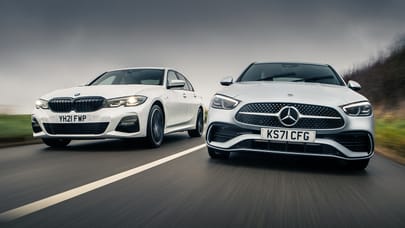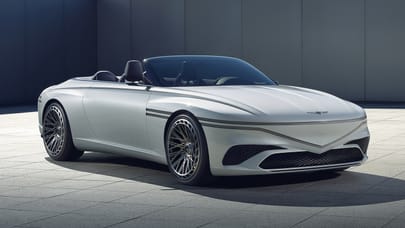
Here are Mercedes-Benz's wild research cars
Have a gander through some of Merc's mobile test-beds


Mankind's insatiable search for knowledge has led us to the forecourt of some magnificent and groundbreaking discoveries. The theory of general relativity; the discovery - albeit accidentally - of Penicillin; the simply magnificent Burger King ‘Meat'normous Omelette' sandwich.
When carmakers have a stab at research, they too find novel methods of propelling human life forwards. Case in point, Mercedes. Since 1969, the three-pointed star has built a number of special vehicles designed solely for the purpose of testing new technology, from fuel consumption, ergonomics and even a Wankel engine. Yes, a Mercedes Wankel engine. Don't confuse these with concept cars, because they're not concepts.
We thought this would be a dandy opportunity to showcase some of their earlier efforts, that - we have to admit - look rather smashing.
Advertisement - Page continues belowMercedes C111-I

This gullwing-doored "test lab on wheels" was Merc's toe into rotary-engined waters. The first, dubbed C111-I, debuted at the 1969 Frankfurt motor show with a three rotor unit developing 280bhp, allowing for a top speed of 162mph. Not bad, considering it was 1969: the same year John Lennon and his missus decided to stage their ‘bed-in' peace protest.
Mercedes C111-II

A few months after Frankfurt, the C111 was revised, and at its 1970 Geneva motor show debut, featured a four-rotor Wankel engine with 350bhp. This added boost allowed the Merc to accelerate from 0-62mph in just 4.8 seconds and on to a top speed of 186mph; figures that would not disgrace it in today's sportscar rankings.
This Wankel engine never made it through the test stages, though. Merc replaced it with a diesel engine and went about setting some speed records on the Nardo test track.
Advertisement - Page continues belowMercedes Auto 2000

The battle of the bulge was met in the late 1970s when the Federal German Ministry for Research and Technology launched the ‘Auto 2000' project: a vehicle with a kerbweight of up to 2,150kg could not exceed 21.3mpg.
Mercedes Auto 2000

Merc's entrant, that premiered at the 1981 Frankfurt motor show, had a low drag co-efficient (0.28) and housed three different test engines: a 3.8-litre V8 petrol engine with cylinder shutoff, cutting out four of the eight pots when less power was used; a 3.3-litre twin-turbo diesel with 31.3mpg at 75mph, and a gas turbine engine.
Anybody else reckon its got more than a whiff of the 6000 SUX from Robocop?
Mercedes NAFA

This odd-looking tyke is the research car that laid the groundwork for the first A-Class and Smart: meet the ‘short-distance vehicle'.
When it arrived in 1981, it contradicted everything Mercedes-Benz was renown for: a car that measured 2.5m long and 1.5m wide and who's purpose was to solve the problems of congested streets and tight parking. Not lording it over punier motorists.
Mercedes NAFA

It had front-wheel-drive, four-wheel-steering, a turning circle of 5.7m and two forward-opening sliding doors. Just look at it's lil' face!
Advertisement - Page continues belowMercedes F100

This was the first of the ‘F' series research cars, and came with a central driving seat. But throw away any notions of the McLaren F1, this car was all about crash safety, sophisticated ergonomics and lots of sensors to ease the pain of driving what looked like an MPV.
Mercedes F100

It made its debut at the 1991 Detroit motor show, featured a modified engine operating on hydrogen running the front wheels (a ‘novelty' for Mercedes at the time), a radar system monitoring traffic and optical fibres running the electrics.
Advertisement - Page continues belowMercedes C112

This is more like it: a 6.0-litre, V12-engined prototype designed to test the very limits of suspension to accommodate better handling. The C112 was a direct result of the C11 Group C racer that helped Sauber claim the 1990 world championship.
That V12 pumped out 408bhp and 428 torques, all attempting to unsettle the new Active Body Control: Merc's ‘active' suspension.
Mercedes C112

Each wheel was equipped with a combination of spring and hydraulic servo cylinders, while sensors detected vertical vehicle movement, as well as roll and pitch. It also features active rear-wheel steering, an adjustable front spoiler and rear airfoil and, crucially and most importantly, gullwing doors.
Mercedes Various Research Car

Meet the Mercedes saloon-estate-convertible-ute. Yes, it really is four cars in one. Launched at the 1995 Geneva motor show, this four-in-one hotchpotch was Merc's take on the having cake/eating cake principle.
The base is a compact, two-door car, featuring a single piece body consisting of roof, side walls and rear section. Here's the good bit: the body simply lifted off to be changed for another variant. Customers didn't store the bodystyles at home, the idea being you drove into your nearest dealer, drank a hot beverage and waited for a spotty work experience technician to change your saloon into a summer drop-top.
The body variants were made from carbon-fibre reinforced plastic and weighed in between 30kg and 50kg each. Still want that crossover?
Mercedes Various Research Car

You can have it as an estate...
Mercedes Various Research Car

... as a saloon...
Mercedes Various Research Car

... as a convertible...
Mercedes Various Research Car

... or a pick-up.
Mercedes F200 Imagination

How would you prefer to control a 6.0-litre V12 with 400bhp? A steering wheel? While puffing on a pipe? Via an appropriately dressed manservant?
Well TopGear.com readers, in 1996 at the Paris motor show, Mercedes showed us a vision of a CL-ish two-door with said V12, being controlled by drive-by-wire joysticks: one mounted centrally to accelerate and brake, while one to turn left and right was mounted on each door, allowing both front occupants the opportunity to become pilot.
Mercedes F200 Imagination

Mercedes also decided to fit active body control, a window airbag, video cameras in place of rear view mirrors, mobile phone voice recognition and again, most importantly, swivelling gullwing doors that would later find a permanent home on the SLR McLaren.
Mercedes F300 Life Jet

This was an altogether different take on getting a car ‘sideways'. With the Life Jet, Merc wanted to blend the open-air physicality of driving a motorbike with the added benefits of seat-belts. And another wheel.
This research car was built using a lightweight aluminium chassis weighing just 89kg with a removable roof, a 1.6-litre 102bhp petrol engine from the A-Class and rear-wheel-drive. Literally, ‘cos there's just one wheel.
Mercedes F300 Life Jet

‘Active Tilt Control' was one of the key technologies for this car, using a hydraulic cylinder on the front axle pressing on one of two spring struts so that wheel and body go into the tilt angle, with the help of a friendly on-board computer.
Mercedes F400 Carving

The goal on the Carving was to build on the camber angle tech first researched in the previous Life Jet. So the camber control on this car can handle strenuous cornering forces, using hydraulics to tilt one or more wheels to a "precisely computed angle" during oversteer or understeer to stabilise it.
And in emergency braking, all four wheels can be immediately cambered so that the insides of the wheels - with friction-optimised tread - get road contact, shortening stopping distance by five metres.
Mercedes F400 Carving

Drive-by-wire is used again, while a hydropneumatic system helps the springs and dampers maintain a good ride. As for the design, anyone else get a whiff of mini-SLR Stirling Moss?
Mercedes F500 Mind

Internet, for your viewing pleasure, a big, box-shaped Mercedes with a 4.0-litre V8 diesel. And an electric motor. Welcome to the hybrid drive.
That V8 produces 250bhp to power the car and the batteries, along with a 67bhp electric motor operated in isolation in creeper mode or together with the V8 in maximum attack mode.
Mercedes F500 Mind

The doors could open in a ‘butterfly' direction - ie, the other way - while the B-pillar could be unlocked and removed, to allow a 1.9m wide opening.
Merc also fitted a night view system (that debuted in the 2005 S-Class), a multi-vision display and even a folding lap table with computer to monitor the vehicles systems. Not to check your MyFace page, obviously, or download Burt Bacharach.
Mercedes bionic car

This is a Mercedes based on a boxfish. Really. A boxfish. They looked to the natural world for answers on drag co-efficient, and developed a lightweight, diesel-engined car based on the dimensions of a boxfish. Because boxfish have low drag co-efficients. Merc's one is also very low, if you wanted to know. That is all.
Mercedes F600 HY Genius

This Merc boasts 81mpg. Or thereabouts. It's powered by a 116bhp zero-emission fuel cell drive and has a range of around 250 miles on one tank of hydrogen. And energy that isn't used for driving is stored in a lithium-ion battery, or used to cool/heat beverages, to serve as a mobile power plant and even power electrical appliances. Handy, when you get an 8.30am craving for a smoothie.
Mercedes F600 HY Genius

There are video cameras to assist with safe lane changes, flashing lights used for emergency brakes (later used for the S-Class), space-saving front doors, and a two-part tailgate.
Mercedes F700

Here is a stunning four-door saloon with a 1.8-litre turbocharged four-pot engine making 240bhp, allowing a 0-62mph time of 7.5 seconds and a top speed of 124mph. All this, and fuel consumption of 44.3mpg and emissions of 127g/km of CO2.
The highlight of this Merc is the ‘Diesotto' engine; a twin-stage turbo together with an electric motor to give a total torque figure of 395lb ft. It also comes with frickin' lasers that scan the road to anticipate poor surfaces and manage the active suspension (earning it the nickname ‘flying carpet'), together with a luxurious and ‘cinematic' interior and the ‘Aqua Dynamic' design language.
Mercedes F700

You can even position the rear seat on the passenger's side to face backwards, should you wish.
Mercedes F800 Style

This five-seater luxury saloon with a plug-in hybrid drive composed of a V6 petrol engine with 300bhp and a battery producing 109bhp. With CO2 emissions of just 68g/km and a 0-62mph time of 4.8 seconds, it is a good example of being all things to all people.
In the F-Cell variant, the electric motor in the rear pushes out 136bhp, with propulsion power generated by a hydrogen fuel cell.
Mercedes F800 Style

The ‘Style' also gets a Human Machine Interface a-la Minority Report, and a traffic jam helper that follows the vehicle in front automatically, even around corners, at speeds of up to 25mph.
Along with this tech, it showcased Merc's design language too.









